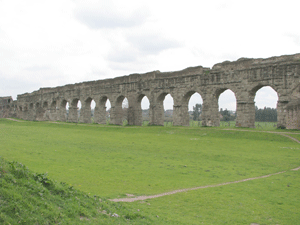
Unlike the Aqua Traiana, substantial remains
of the Aqua Claudia, begun by the emperor
Caligula in A.D. 38 and completed by Claudius
in A.D. 52, still stand outside of Rome. The
aqueduct traveled for more than 40 miles
from its source and provided the city with an
ample water supply.
(Wikimedia Commons)
Ancient aqueducts were essentially man-made
streams conducting water downhill from the natural
sources to the destination. To tap water from a
river, often a dam and reservoir were constructed to create
an intake for the aqueduct that would not run dry during
periods of low water. To capture water from springs, catch
basins or springhouses could be built at the points where the
water issued from the ground or just below them, connected
by short feeder tunnels. Having flowed or filtered into the
springhouse from uphill, the water then entered the aqueduct
conduit. Scattered springs would require several branch
conduits feeding into a main channel.
If water was brought in from some distance, then care
was taken in surveying the territory over which the aqueduct
would run to ensure that it would flow at an acceptable
gradient for the entire distance. If the water ran at too
steep an angle, it would damage the channel over time by
scouring action and possibly arrive too low at its destination.
If it ran too shallow, then it would stagnate. Roman
aqueducts typically tapped springs in hilly regions to ensure
a sufficient fall in elevation over the necessary distance. The
terrain and the decisions of the engineers determined this
distance. Generally, the conduit stayed close to the surface,
following the contours of the land, grading slightly downhill
along the way. At times, it may have traversed an obstacle,
such as a ridge or a valley. If it encountered a ridge, then
tunneling was required. If it hit a valley, a bridge would be
built, or sometimes a pressurized pipe system, known as an
inverted siphon, was installed. Along its path, the vault of the
conduit was pierced periodically by vertical manhole shafts
to facilitate construction and maintenance.
Upon arrival at the city's outskirts, the water reached a
large distribution tank called the main castellum. From here,
smaller branch conduits ran to various districts in the city,
where they met lower secondary castella. These branched
again, often with pipes rather than masonry channels, supplying
water under pressure to local features, such as fountains,
houses, and baths.
 Feature: Rome's Lost Aqueduct
Feature: Rome's Lost Aqueduct
 Video: The Search for the Aqua Traiana
Video: The Search for the Aqua Traiana
Rabun Taylor is associate professor of classics at the University
of Texas at Austin.

